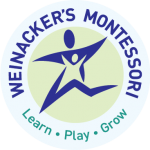Technology is everywhere around us. Children today are surrounded by technology, just as they are surrounded by nature. Personally, I am a self-confessed technology junkie. I have digital calendars, to-do lists, and many “smart” gadgets that help make day to day life a bit easier. My older children have been issued laptops from school that contain all of their textbooks and classes.
According to a study from Common Sense Media, 98% of homes with children now have personal tablet devices. and in 42% of homes the television is “always” on.
Technology use has become a hotly disputed subject in the 21st century. There are many scholarly articles stating that screen time should not be used for younger children. There are just as many articles that expound on the benefits of learning with the aid of technology. At Weinacker’s we feel that children have enough screen time at home, so we do not provide technology as part of the daily work cycle. However, if technology is part of our children’s world, how can we implement it in our home learning processes and still honor the Montessori approach?
A simple search in the app store leads to multiple Montessori apps. Do not be fooled into thinking that these apps can replace the beautiful wooden work found in the classroom. These apps are simply extensions to learning. Maria Montessori was adamant that the learning of abstract ideas begins with the child experiencing materials with the child’s own hands using concrete objects. Once the child becomes proficient with a work and can work with the objects independently, then extensions may be used.
Problems may arise when we seek to replace concrete objects with the abstract (games and apps) too early. A good example would be the Pink Tower or Brown stair work. When a child is using this material to learn they are able to visually see and feel the 1 cm increments between each piece of the work. They are able to see and hear the tower topple if the blocks are stacked in the incorrect order. Swiping the blocks on a screen leaves out the sensory learning that helps to internalize the algebraic concepts of learning provided with these materials.
Without a doubt the technology age has provided us with many tools to help us learn, as well as many ways to make our lives easier. There are also many Montessori apps and materials that we can use at home to help our children learn. However, we should always be mindful of teaching the whole child. We must engage all of the senses to make a lasting educational impact upon our children.

